Thinking about a pool for your home in Mackay? It's a classic dream. The kids splashing around on a hot day, a quiet dip after work, or just having a beautiful view out the back window. But getting there means making big decisions, and the first is always: fibreglass or concrete?
Now, let's be upfront. We specialise in installing beautiful fibreglass pools. We think they're a fantastic choice for most families. But our main goal isn't just to sell you a pool, but to help you find the right one for your home and your needs. We believe the best way to do that is with honest, straightforward advice on both options.
To help you choose, we're going to break down some differences between fibreglass and concrete pools. We will look at everything that matters initially and in the long run so that you can make the best decision with confidence.
Highlights
- Fibreglass pools arrive as ready-made shells, with fast installation and lower unpredictable costs for homeowners.
- Concrete pools are built on-site, offering unlimited custom sizes, shapes, depths, and features, but with higher costs and longer build times.
- Maintenance costs for fibreglass pools are significantly lower, with easier cleaning due to the smooth, non-porous gel coat surface.
- Concrete pools can be resurfaced or remodelled but need more frequent upkeep, higher chemical use, and resurfacing every 10-15 years.
- In Mackay's climate, fibreglass pools require less chemical balancing, while concrete pools demand vigilant care, especially during the tropical wet season.
- Choose fibreglass for simplicity and lower running costs; go concrete for total design freedom and truly customised pool projects.
Understanding Their Basic Difference
A fibreglass pool is a ready-made swimming pool shell built from layers of strong fibreglass material. The shell arrives at your home in one piece, and workers place it into a hole that's been dug to fit its size and shape.
In manufacturing, fibreglass pools are crafted using a mould. Several layers of chopped strand mat, woven fibreglass, and resin are applied over the mould, then cured to form a rigid, waterproof shell. A gel coat is added for a smooth, protective finish.
The image below is The Harvest, a signature fibreglass pool by Harvest Pools.
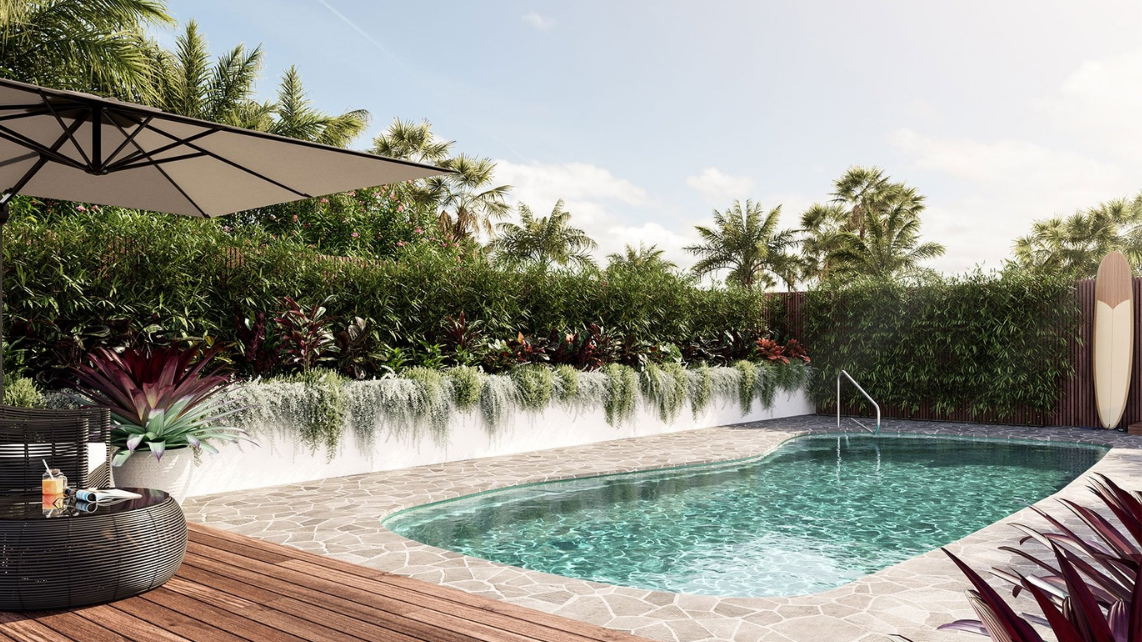
A concrete pool, on the other hand, is a swimming pool made by pouring concrete into a shape that's been dug out in the ground. Unlike fibreglass pools, these pools are built on-site, so they can be any size or shape you want.
It is constructed by first creating a steel-reinforced framework inside the excavated hole. Builders then spray or pour a concrete mixture over this framework, shaping it as needed. Once the concrete cures, a finishing layer of plaster, tiles, or pebblecrete is applied for a watertight seal and final appearance.
Below is an example of a modern concrete pool featuring a built-in spa and an elevated overflow hot tub, perfect for relaxation and entertaining.
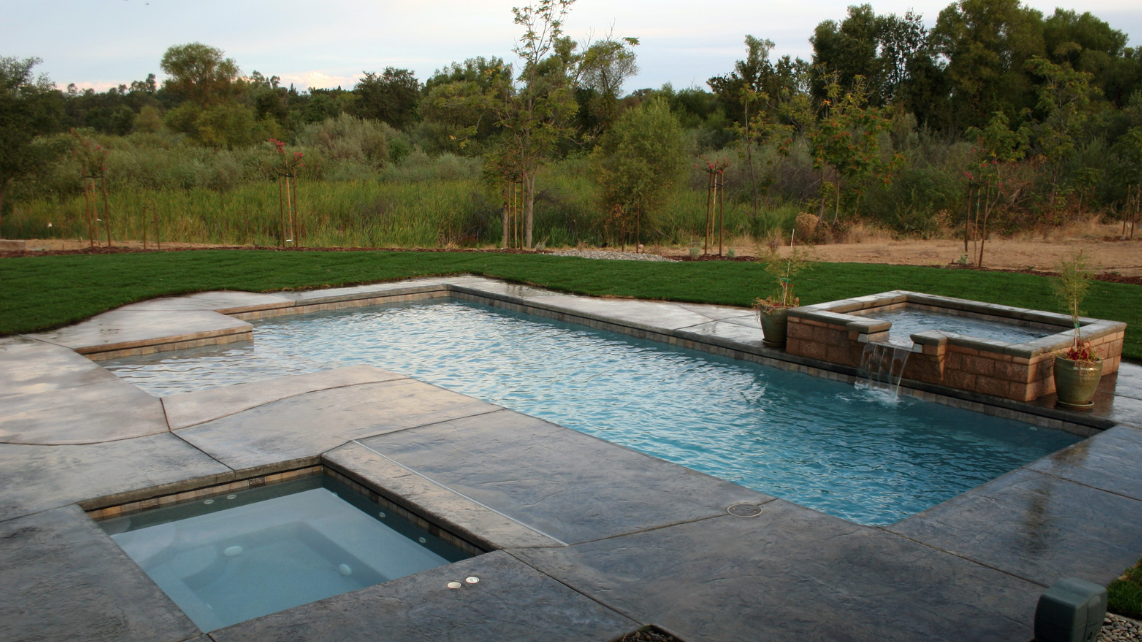
Costs
Fibreglass
The upfront price for a fully-installed fibreglass pool in Australia, specifically in Mackay, usually ranges from $55,000 to $85,000, depending on the size and site conditions. For bigger or premium models, the price can reach $90,000 or more, with the shell itself often costing between $18,000 and $35,000.
Based on what we've calculated for years, fibreglass pools are 15% to 20% cheaper to install than concrete pools. The cost is more predictable since the shell is pre-made, and installation is pretty straightforward. Factors like site access and soil can affect the final price, though most installations stay within the quoted range.
Maintenance and electricity are also cheaper, with annual upkeep often around $500 to $1,000. Over the years, fibreglass pools can save you up to 75% on maintenance compared to concrete, and unless you did something to the gel coat, there's no need for resurfacing.
If you would like to learn more about the additional costs to consider, click here to check our blog post that outlines initial, ongoing, and add-on costs for fibreglass pool installation in Mackay.
Concrete
The upfront price for a concrete pool is much higher, usually starting from $50,000 and often reaching $75,000 or more for a standard backyard pool. Smaller concrete pools may start at $35,000 to $40,000, but custom or large designs can exceed $100,000.
Concrete pools come with extra costs for various factors, such as site preparation, design, and finishing. It can mean more labour and longer build times as well. And always check what's included in the project, as tiling, paving, and heating are often additional expenses.
Besides the huge upfront, they can be more expensive to maintain in the long run. Expect annual maintenance costs of $2,000 to $3,000, plus resurfacing every 10-15 years, which can cost $10,000 to $15,000. Additionally, electricity and chemical use are also higher due to the porous surface of the concrete pool.
Appearance, Surface, and Customisation
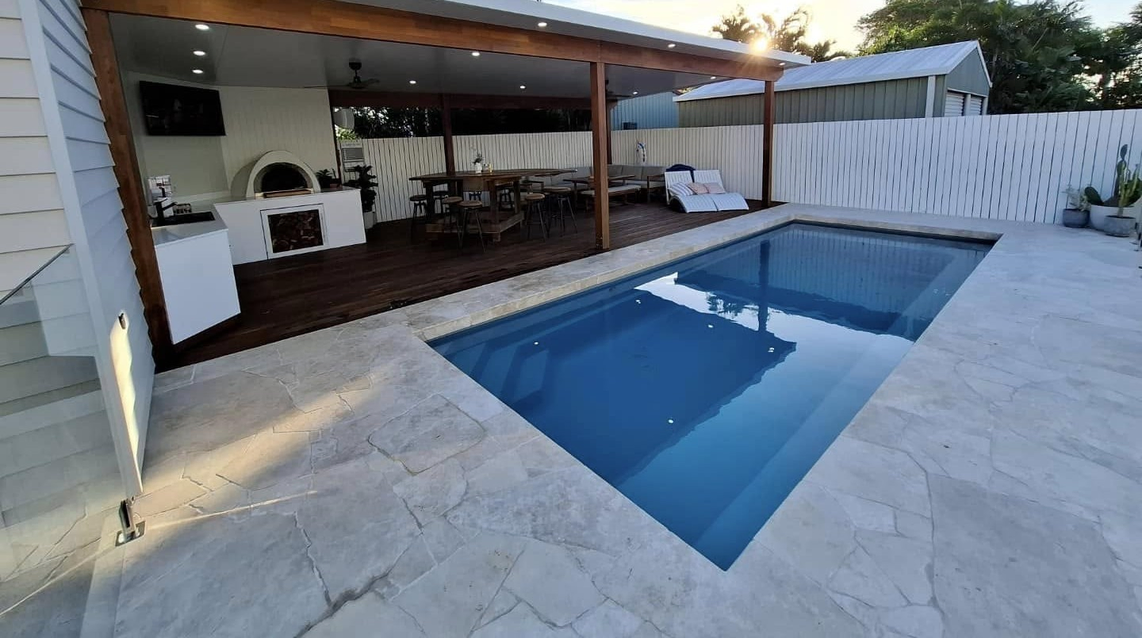
Fibreglass
Fibreglass pools come in a range of shapes and sizes, from classic rectangles to freeform curves. The internal structure is strong, with built-in steps and seating moulded straight into the shell. This makes the pool sturdy and easy to install.
The surface of a fibreglass pool is made of a smooth gel coat. It feels soft underfoot and is gentle on the skin, with no sharp or rough spots. The non-porous finish helps stop algae from sticking and makes cleaning much easier.
Since the size and shape are already determined and ready to install, customisation for fibreglass pools is very limited. You can pick from different colours, patterns, and features like built-in ledges or swim-outs. But the thing is, you can't change the basic shape or size beyond what's available in the range.
Concrete
Unlike fibreglass pools, concrete pools are built from the ground up, which allows for almost any shape or depth you want or need. Once again, it is formed using steel reinforcement and sprayed or poured concrete, which is then shaped and finished on-site.
The surface of a concrete pool can be finished with plaster, tiles, or pebblecrete. It can feel rougher than fibreglass, especially if you choose a pebble or aggregate finish. Over time, the surface may get even rougher and need resurfacing.
If you want to customise your pool, like adding beach entries or custom steps, a concrete pool is your best choice. You can also choose any shape, size, or depth. The design can be matched to your garden or any unique vision you have, since it will be constructed directly in your backyard.
If you want to add a spa, water features, or special lighting, concrete pools also make it easy. You can even mix different finishes and colours to create the truly one-of-a-kind backyard pool that you've been dreaming of.
Installation Time
Fibreglass
A fibreglass pool can be installed surprisingly fast. Once the shell arrives together with the mobile crane, the actual installation usually takes about one to three weeks, including excavation, setting the shell, plumbing, and backfilling. If your site is straightforward and the weather behaves, you could be swimming in as little as seven days.
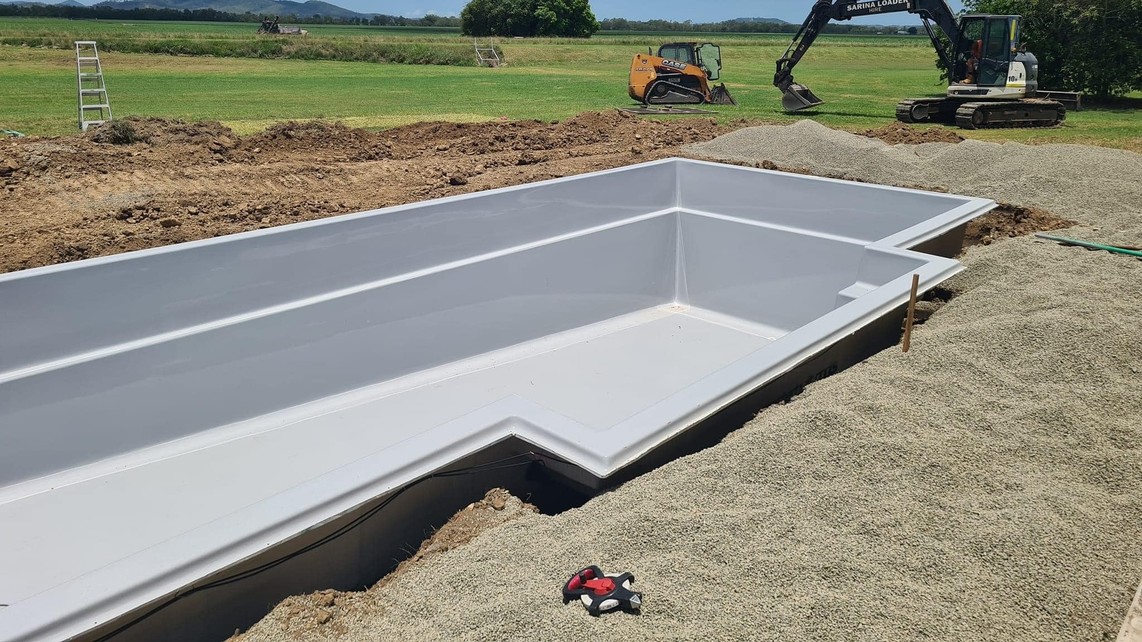
Landscaping, fencing, and finishing touches may add another week or two, depending on your plans if they are just simple or a bit complex. All up, most families see their fibreglass pool ready to use within three to four weeks from the start of groundworks.
But always expect delays, especially if there's rain, tricky access, or council approvals that may take longer than expected.
Concrete
Building a concrete pool is a much longer process. It's just the same as building the masonry of your house using concrete. Mix, construct, cure.
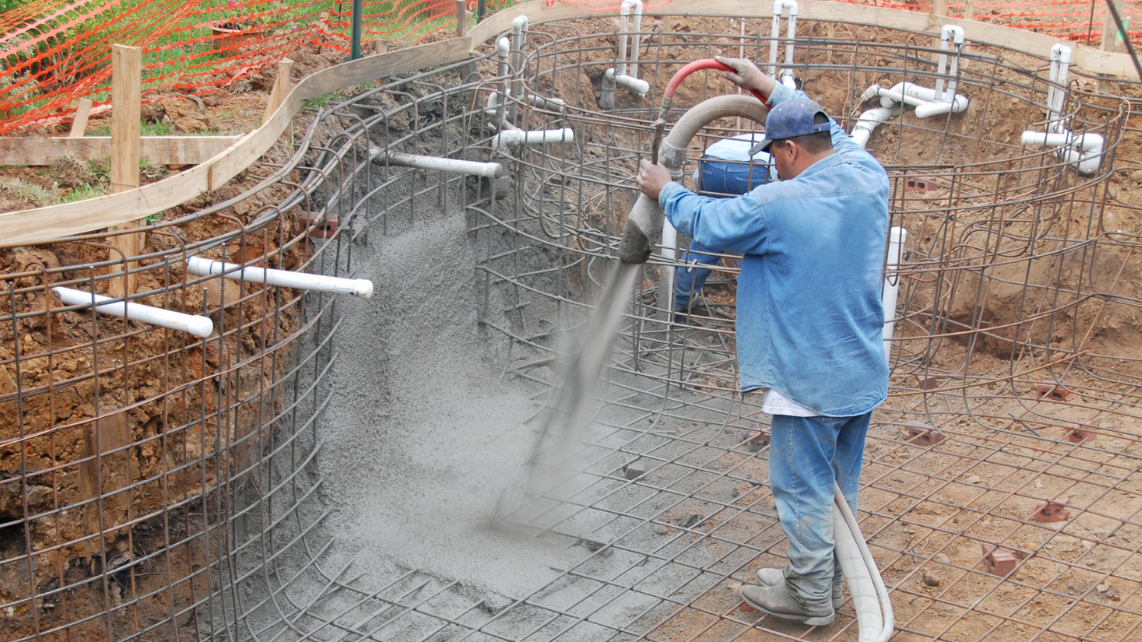
The first phase is site preparation and excavation, which can take one to two weeks, depending on the size and complexity of the pool and your property. After that, steel reinforcement and plumbing are installed, followed by spraying or pouring the concrete shell. This stage alone usually takes another week or two.
Once the shell is in, the concrete needs to cure for about 28 days to reach its full strength. After curing, finishing touches like tiling, coping, and fencing are added, which can take several more weeks.
In total, the whole process from start to finish usually takes between three and six months. Like what can happen to fibreglass pool installation, weather, design changes, and council approvals can all stretch out the timeline even further.
Maintenance and Upkeep

Fibreglass
Fibreglass pools are known for being easy to look after. The smooth, non-porous surface means algae and dirt find it hard to stick, so you'll spend less time scrubbing and more time swimming.
Water balance is simple to maintain in a fibreglass pool. The gel coat finish doesn't react much with pool chemicals, so you'll use fewer products and save money over time. This also means less risk of skin or eye irritation for swimmers.
Repairs are rare with fibreglass pools. The shell is tough and doesn't crack easily. If there is ever a problem, like a small blister or chip, most fixes are quick and not too costly. You won't need to resurface the pool for decades.
Concrete
Concrete pools need a bit more attention. The rough, porous surface can attract algae, so regular brushing is a must. You'll also need to vacuum and skim the pool more often to keep it looking clear.
The concrete surface can affect your pool's water chemistry. It's common to use more chemicals to keep things balanced. The concrete affects the pH and alkalinity of the water, so you'll need to test and adjust it more often. This can mean higher costs for chlorine, acid, and other treatments, especially during summer or after heavy use.
Every 10 to 15 years, most concrete pools need resurfacing to keep them watertight and looking good. This is a big job and can be expensive. Cracks or chips in the surface may also need patching up, adding to your maintenance list.
Durability
Fibreglass
A well-built fibreglass pool can last anywhere from 25 to 50 years, with many manufacturers offering lifetime structural warranties and at least 20 years on the internal finish. Of course, it depends on whether it underwent proper installation and has regular maintenance, which helps prevent issues like fading or blistering.
Fibreglass pools are tough and flexible, making them less likely to crack under ground movement or shifting soil.
Concrete
A concrete pool is built for the long haul, often lasting 50 years or more if looked after properly. The concrete shell itself is incredibly strong and can handle decades of use and harsh weather without losing its shape. Just think of your concrete house again, but the only difference is the stress factors it is against, which are the soil and water.
One big advantage is that concrete pools can be repaired, resurfaced, and even remodelled as needed. While the surface finish will need redoing every 10 to 15 years, the underlying structure is made to last and can outlive most other pool types.
Climate and Chemistry
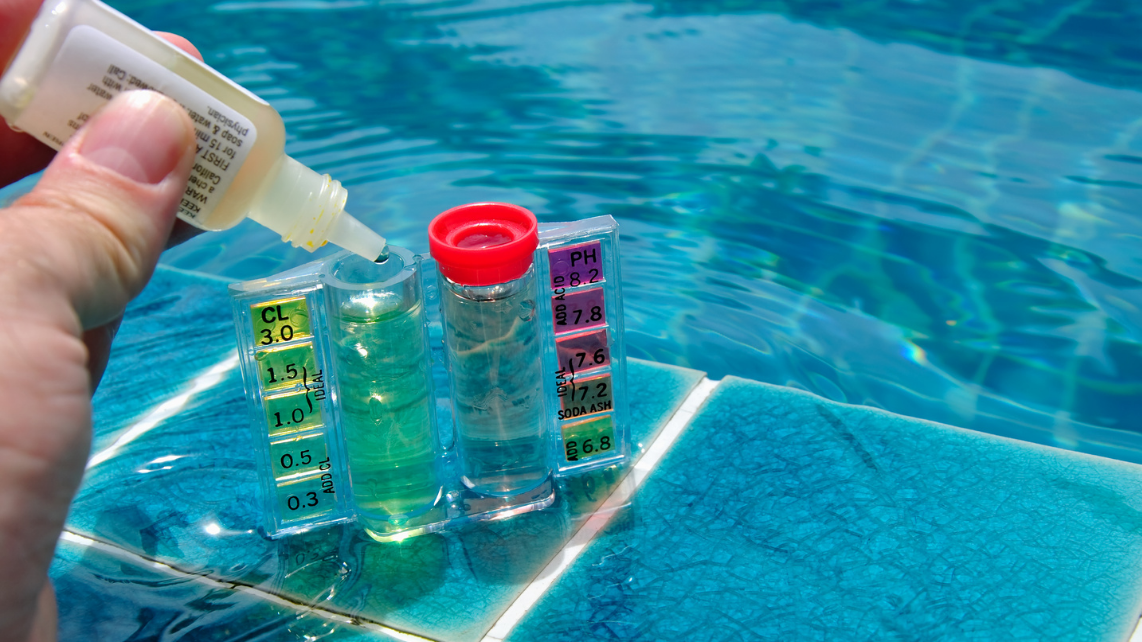
Fibreglass
Fibreglass pools handle tropical climates really well. The hot, humid summers and mild, dry winters in Mackay won't bother a fibreglass shell. The material is flexible, so it resists cracking and damage from ground movement or temperature swings. Even with heavy rain or storms, the structure stays stable and secure.
Like what was mentioned, the smooth, non-porous gel coat surface helps keep algae and bacteria at bay, which is a big plus in humid weather. You'll spend less time scrubbing and adding chemicals, even during the wet season. This makes pool care simpler, especially when humidity is high and debris builds up quickly.
When it comes to water chemistry, fibreglass pools need less fuss than concrete. The gel coat doesn't react with water or pool chemicals, so you don't have to worry about calcium levels as much. Just keep the pH steady between 7.2 and 7.8 and chlorine in the recommended range.
The pool also heats up quickly and holds warmth, which is handy for year-round swimming in our climate.
Concrete
Concrete pools are tough enough to handle Mackay's heat and humidity, but they do need more attention. The porous surface can soak up water and chemicals, making it easier for algae to grow, especially in the wet season. That's why you'll need to keep up with regular cleaning and chemical treatments to prevent algae and staining.
I hate to break it to you, but water chemistry, especially in the wet season, is a bit more demanding with concrete. The surface can react with pool water, so you need to keep an eye on calcium hardness, pH, and alkalinity. If the water gets too soft or acidic, it can eat away at the plaster or grout. High rainfall can also dilute chemicals, so you'll be testing and adjusting more often during the wet months.
Concrete pools may lose more water to evaporation during hot, sunny days, and the surface can warm up more slowly than fibreglass. Using a pool cover helps keep water levels steady and saves on heating.
You can still consider having a concrete pool, though. With the right care, it will still last for decades, but it really does need a bit more attention in Mackay's tropical climate.
Which Pool Is Best for You?
When to Choose Fibreglass
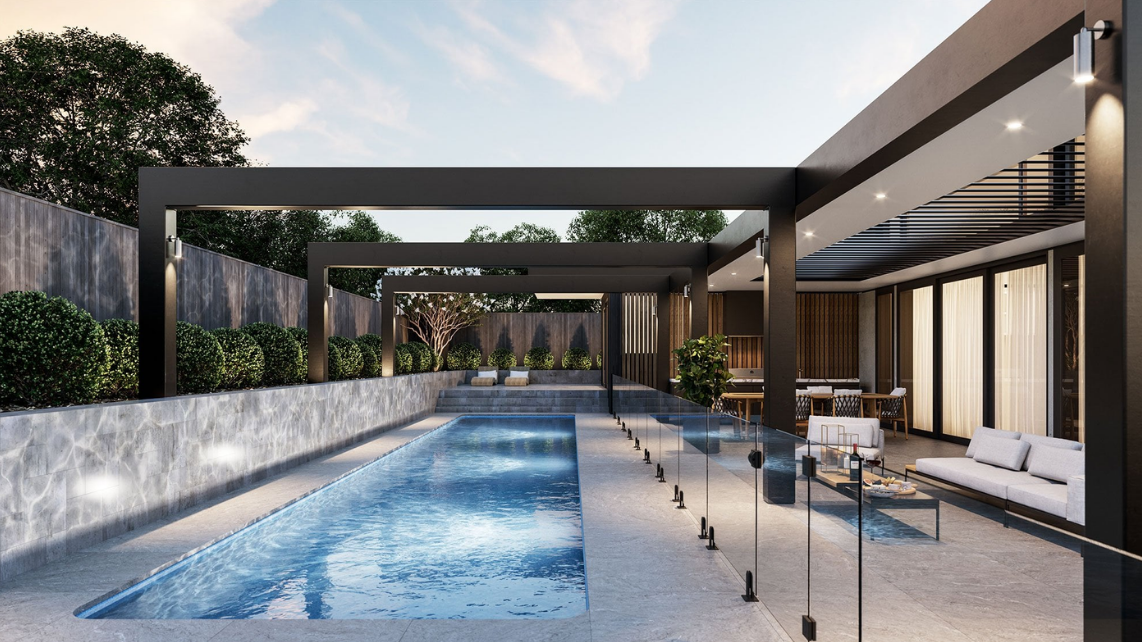
If you want a fast installation, lower running costs, and a pool that's easy to maintain, you should go for a fibreglass pool. It's a very smart choice for families who want a reliable pool without the hassle of constant upkeep or expensive repairs.
If you're happy with the shapes and sizes available from the manufacturer, you'll enjoy a smooth, low-fuss swimming experience. These pools suit most Queensland homes, especially Mackay, where the climate is humid.
A recap of fibreglass pool advantages:
- Lower upfront and lifetime costs
- Quick installation (usually 1–4 weeks)
- Smooth, non-porous surface resists algae
- Less chemical use and easier water balance
- The flexible shell handles ground movement well
A recap of fibreglass pool disadvantages:
- Limited custom shapes and sizes
- Can develop surface blisters if not properly maintained
- Repairs need specialist materials
- Transport size limits for large pools
- May not suit sites with poor access or unusual layouts
When to Choose Concrete
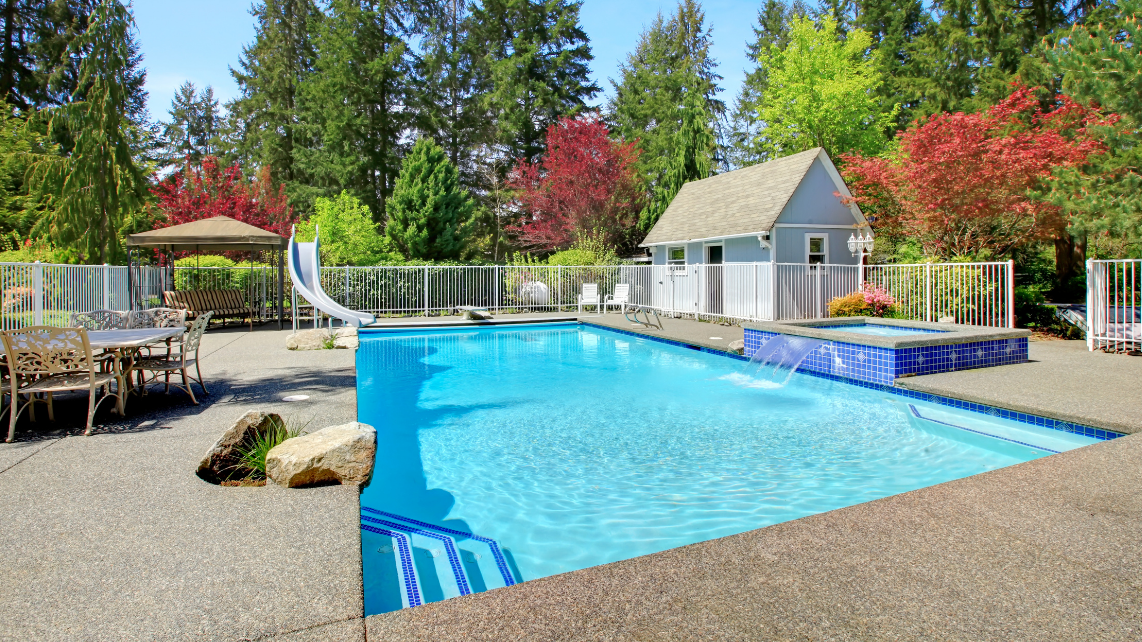
A concrete pool is best if you want a totally custom design, a unique shape, or extra features like a spa or infinity edge. Go for concrete if your property has tricky access, or you want a pool that can be built to any size or depth.
Just be prepared for a longer build and higher costs, both upfront and over the years. Concrete pools suit those who want a statement feature and are ready to put in the time and effort for maintenance.
A recap of concrete pool advantages:
- Unlimited design, size, and depth options
- Can add custom features and finishes
- Incredibly strong and long-lasting structure
- Can be resurfaced or remodelled as needed or desired
- Handles complex sites and landscaping well
A recap of concrete pool disadvantages:
- Higher upfront and ongoing costs
- Longer installation time (usually 3–6 months)
- Needs more chemicals and regular cleaning
- The surface can feel rough and may need resurfacing
- Prone to algae and staining in humid climates
Final Thoughts
We've covered everything from costs to climate so you can weigh up what matters most for your home, budget, and pool desires. We are grateful for reading this guide to make it easier for you to decide which pool fits your lifestyle and your backyard dreams.
Take your time and think about what's practical for your family. The right pool should bring you joy, not extra stress. If you're ever unsure, just ask for advice - there's always help around.
If you ever need help with your fibreglass pool project, just reach out to us. We are licensed installers with years of experience installing fibreglass pools in Mackay, and we're happy to chat or give you a quote.
And if you're still thinking about which fibreglass pool to choose, check out the fibreglass pool designs our partner offers. There's always something for every backyard and budget.
